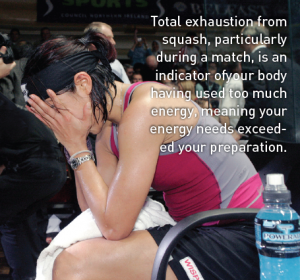By Candace Chemtob, B.S. and M.S. in Human Nutrition
Playing squash requires an enormous amount of energy. Ask any player and they will confirm this. Science supports this observation. Studies have quantified the energy demands of various sports and squash tops almost all sports including basketball, soccer, football, and ice hockey. To perform at your peak potential on the court, your energy needs to be met or exceeded. If you are in an energy deficit (not consuming as many calories as you burn), your performance will be diminished. For this reason, squash players looking to optimize performance can benefit from a basic understanding of energy metabolism.

The most fundamental, essential function of food is to provide energy. The original source of all food energy is the sun. Using the sun’s energy, plants convert carbon dioxide and water into glucose, the building block of all foods. This process continues up the food chain until reaching the top. At the top of the food chain, food is eaten (enjoyed) by humans. After being consumed, all food is eventually broken down. At a cellular level, the bonds that hold together the basic elements of food (carbon, oxygen, hydrogen, and nitrogen) release their stored energy. This energy is captured (primarily as ATP) and is used to fuel all the body’s activities, including physical activity.
How do we measure the energy in food? Calories! Surely, most of you are familiar with calories, but what is a calorie? A calorie is simply a measurement of heat energy. There are three energy containing macronutrients: fat, carbohydrates, and protein. Carbohydrates and protein each contain 4 calories per gram. Fat has more than double the amount of calories, at 9 calories per gram. One other source of calories in our diet is alcohol, containing about 7 calories per gram.
Being in “energy balance” (“energy in” equals “energy out”) is a state when your energy needs are met by your diet. “Energy in” can be determined by counting calories. “Energy out” is total daily energy expenditure (TDEE) and can be calculated or measured. The components that make up total daily energy expenditure (TDEE) are:”
Resting metabolic rate (RMR) comprises 65 to 75% of the body’s total energy needs and is the amount of energy it takes to perform life’s basic functions like breathing, cardiovascular, brain activity, etc. Most commonly, RMR is predicted plugging height, weight, and age into an equation. RMR can also be measured by a method called indirect calorimetry and is preferred in athletes. Indirect calorimetry should be measured under controlled conditions by a healthcare professional.
Thermic Effect of Food (TEF) is the amount of energy it takes to digest, absorb, and process food. TEF accounts for 10% of total daily energy expenditure.
Energy required for physical activity. The amount of energy required for physical activity includes all daily activities, walking, climbing stairs, and of course, sports. As previously mentioned, the energy demands of squash are significant. Playing squash requires approximately 850 (McArdle and Katch) to more than 1,000 calories (American college of Sports medicine) per hour. To put this in terms of energy demands, one hour of squash is the equivalent of running 7.5 miles (and a lot more fun!).
Energy required for growth. Growing junior squash players have added energy demands for growth. It is critical for junior squash players to meet their energy demands. To reach one’s height potential, a child must meet their energy needs consistently. Most importantly, chronically running in an energy deficit will stunt (linear) growth, but it will also affect athletic performance. For competitive junior squash players on a hard training schedule, they will at times require caloric intakes of upwards of 5,000 calories per day. Squash parents, this means that your child may need to eat two to three times more food than you.
Let’s run through some basic “numbers” for adult squash players. If the average male squash player (playing 1 hour per day) was 150 pounds, 5’10” and 40 years old, his total daily energy expenditure would be approximately 3100 calories per day. For a 40 year old female player (assuming a weight of 125 pounds, height of 5’5”), playing one hour per day, her TDEE would be approximately 2700 calories per day. For competitive players on the court for more than one hour per day, these numbers can be considerably higher. Additionally, there are other factors that can affect energy expenditure. A consultation with a sports dietitian can provide an athlete with an accurate assessment of their individual energy needs.
To conclude, I’d like to simplify the concept of energy metabolism and balance. Weigh yourself. If you are losing weight, whether intentional or not, you are not meeting your energy needs. Competitive squash players are not advised to lose weight during season. For recreational squash players, squash with it’s high energy demands, makes achieving or maintaining a healthy weight relatively easy. Since eating is enjoyable for most of us, the increased energy needs of playing squash can be embraced as a positive “benefit” of the sport. Bon Appétit!




